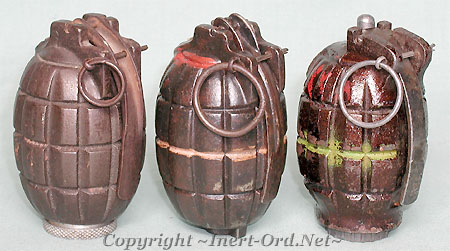
Without a doubt the most successful hand grenade of the 20th Century, having the longest continuous service life of any other type.
While it may not be an ideal design for most efficient function (offset detonator, causing asymmetrical fragmentation) it was simple, rugged and effective.
The Mills Bomb is arguably the iconic example of a 20th century Hand Grenade.
Production commenced swiftly with over 75 million Mills grenades manufactured between April 1915 and late 1918.
The No.36 Mk.I version was introduced at the end of WWI and remained the standard British fragmentation grenade until 1972. The Mills Bomb was in service for over 55 years. It has been copied by at least a half dozen other countries and was still in active foreign service (Pakistan) through the early 1980's.
The term "Mills Bomb" was first coined early in WWI, as grenadiers were referred to as "bombers". The term was confusing and soon "grenade" was officially applied, but the old term continues to be used interchangeably.
